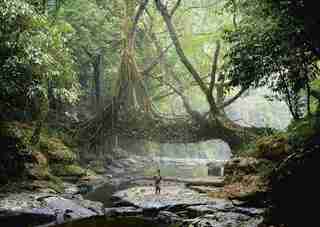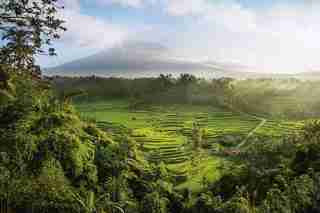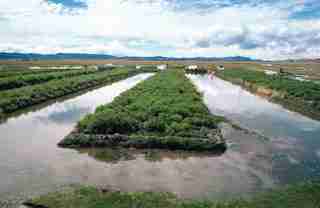When it comes to combating climate change, architects and designers often look to high-tech innovations for solutions. But what if the answers aren’t new but centuries old? In her new book, Lo—TEK. Design by Radical Indigenism ( Taschen, $50), lecturer and landscape designer Julia Watson looks at technologies used by indigenous populations in 20 countries that exemplify how humans can live in harmony with nature. Watson, who was born in Australia, has long been interested in indigenous communities and their relationships to land, nature, and other species. Her research expanded into traditional ecological knowledge (TEK) as a scientific exploration when she began teaching an eco-technology seminar at Columbia University. “In my research for this course, I realized that many of the technologies we see as contemporary green infrastructures have ancient lineages,” says Watson, who points to green roofs and floating wetlands as prime examples of long-established practices repackaged as new innovations. “So I started wondering how many technologies are out there that haven’t been considered as technologies yet, and that question produced Lo—TEK.”
Watson defines Lo—TEK as a design movement that rebuilds an understanding of indigenous philosophy and vernacular architecture, which can help generate sustainable and climate-resilient infrastructure. “Lo—TEK thinking is rooted in the philosophy of radical indigenism,” she says. “Taking its name from the Latin derivation of the word radical, radix, meaning ‘root,’ it was coined by Princeton professor and citizen of the Cherokee Nation, Eva Marie Garoutte, who argues for a rebuilding of knowledge and explores indigenous philosophies capable of generating new dialogues.”
Watson explores designs from Iraq to Tanzania, offering solutions for different climates, including forests, wetlands, deserts, and mountains. “The book retells an ancient mythology—that humankind can and must live symbiotically with nature—and provokes an emergent movement of design,” she says. “This movement intentionally hybridizes the innovations of indigenous peoples across the globe to radicalize the progress of humanism with the spirit of indigenism—thus rerooting our very relationship with nature from superior to symbiotic.” Read on to discover some of the technologies.

The Khasi tribe of Northern India have developed living bridges and ladders in their villages. Growing rubber fig trees are guided across ravines, and the resulting bridges are able to withstand the force of the area’s monsoons. Watson notes that because these bridges are living, they grow stronger over time, unlike artificial infrastructure that degrades.

Subak rice terraces in Bali are one of the world’s oldest socioecological systems. The system has transformed the volcanic landscape into terraced surfaces for agriculture. Self-governing associations of farmers coordinate planting schedules and share water. Complex arrangements of tunnels and canals form irrigation systems that are optimized to support many subaks.

Waru Waru raised terraces and canals are used by the Incan people near Lake Titicaca in Peru. They were created between 500 BCE and 500 CE for astronomical and devotional practices, and from 300 to 1500 CE they were converted into raised beds for crops. The canals are used for irrigation and fishing, and the system has reduced the impact of the area’s extreme conditions.
In the early years of the first millennium BCE, the people of Persia (modern-day Iran) began constructing qanats, man-made underground streams. The qanats redistribute water from mountain aquifers to farmers’ fields and low-lying cities. Spoil craters, seen here, top the qanat’s vertical shafts and keep debris from entering the water system.
The city of Ganvie in Benin, Africa, was settled by the Tofinu tribe, who built bamboo and teak stilted houses on Lake Nokoué. The city is made up of 11 villages, which are surrounded by an artificial reef of 12,000 fish paddocks. The system attracts fish typically found in other areas and increases biodiversity and fish production.
In the southern wetlands of Iraq, an area known as Iraq’s Garden of Eden and the Mesopotamian Venice, the Ma’dan people live on man-made floating islands, or al halif, and tuhul, natural free-floating islands. The villages, called al tahla, feature structures made using locally harvested qasab reeds and formed without wood, nails, or glass.
One type of Ma’dan building is the mudhif, which is made up of a series of arches typically oriented toward Mecca. Dried qasab reeds form columns, crossbeams, ropes and mats for walls and floors, and because the reeds are the only building materials, the structures can be taken down and reassembled in a day.
The Uros people of Peru are one of the few civilizations that live directly on Lake Titicaca. The floating islands are constructed of totora reeds, and each island has multiple thatched houses—between 1 and 15 depending on the size—and are anchored with rocks and rope, so they can be moved at will.
Local totora reeds are harvested from the shoreline and used by the Uros people for everything from boats to blankets to medicine. Today there are 2,629 people living on 91 floating islands.
Lo—TEK. Design by Radical Indigenism ( Taschen, $50).
